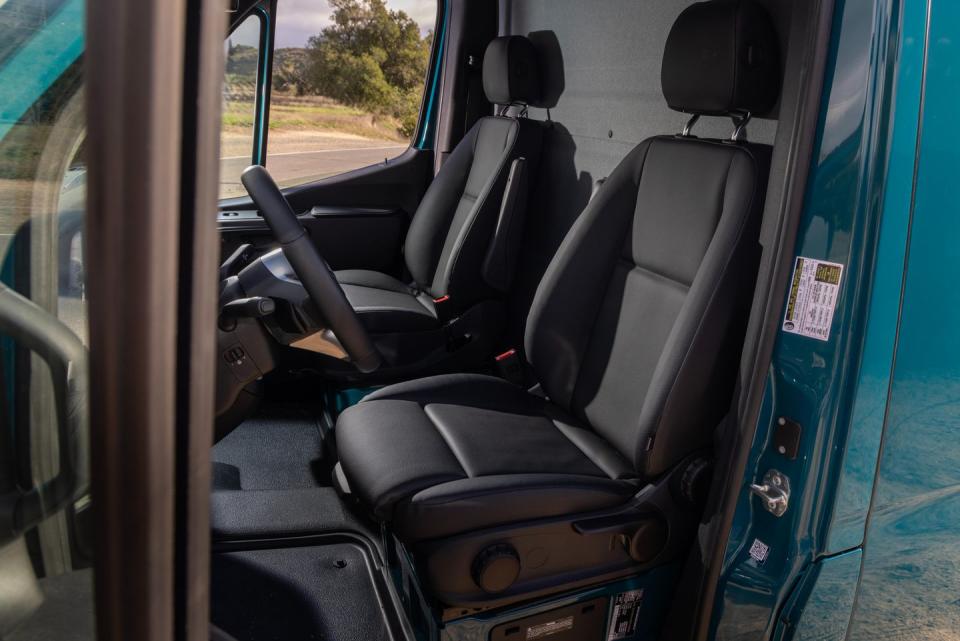Mercedes-Benz Expands Its Electric Offerings with the eSprinter Van

Mercedes brings its all-electric eSprinter commercial van into the North American market right about now, with a range of up to 250 miles and a starting price of $74,161.
The van has a 113-kWh LFP battery stowed under the floor between the frame rails that does not impinge on cargo area.
A single permanent magnet synchronous motor drives the rear wheels.
Hippie #VanLife vloggers rejoice! You can now live your nature-based lifestyles while spewing zero tailpipe emissions thanks to the new Mercedes eSprinter van. Eco-conscious delivery companies can likewise enjoy the benefits of an all-electric fleet—for a $14,000 to $20,000 (or so) price premium over the current diesel van.
There are many advantages to switching to the electric eSprinter: no oil changes, no gas fillups, way fewer—if any—brake pad changes due to regenerative braking, quiet operation if you’re making early morning milk deliveries, and, again, no tailpipe emissions.
The price difference between this new eSprinter and the current four-cylinder diesel-powered Sprinter is not chicken scratch. The diesel version starts at $58,095 including destination, while the least-expensive all-electric eSprinter starts at $74,161.
If you consider that diesel fuel is somewhere around $4.50 a gallon (at least it is here in California where the eSprinter van was introduced) and electricity is about 27 cents a kWh, then it’d take you about 90,000 miles of electric driving to recoup your investment based on fuel alone. Tally up the cost of oil changes and brake pads and you can knock off $2000 to $2500 over that distance if you have an eSprinter. If you live in a state where electricity is cheaper, you’d recoup your electric investment even sooner.

For fleet operators, those numbers make sense, and much of the Sprinter market is commercial. The number of VanLifers living in their Sprinters is fairly small compared to the number of delivery services.
The new eSprinter will be introduced into the U.S. and Canada as a long panel van with a high roof riding on the longer 170-inch wheelbase and fed by a 113-kWh battery. The battery and the electric drivetrain stow under the cargo floor without intruding into the cargo area, meaning the load capacity is the same as the current diesel Sprinter at 488 cubic feet.
“This configuration lends itself to expert upfitter solutions, such as shelving systems, work benches or heavy duty wood floors, and can turn the Sprinter easily into a mobile workshop or a very spacious delivery van,” said Klaus Rehkugler, head of sales and marketing at Mercedes-Benz vans.
At launch, the eSprinter will come with a single permanent magnet synchronous motor driving the rear wheels. Output of the motor can be ordered at either 134 or 201 hp, with both versions delivering “up to” 295 lb-ft of torque for “at least 30 seconds,” according to Rehkugler.

The battery itself is a lithium iron phosphate (LFP) chemistry, not the more common Li-ion makeup. Mercedes says LFP chemistry eliminates the use of rare earth materials such as cobalt and nickel and says cell degradation is lower than other batteries, “ensuring durability and low maintenance requirements.” (Plus, LFPs don’t catch fire.)
The battery rides under the floor between the frame rails while the motor has its own aluminum subframe and also rides underfloor and between the rails.
The whole setup is good for “up to 250 miles,” though we didn’t get to drive it that far. Mercedes said its engineers drove one from Las Vegas to its tech center in Long Beach, California, a distance of 273 miles on a single charge.
I got to drive one about 25 miles.
You can order these with or without a floor-to-ceiling partition behind the two front seats. If you get the partition, you’ll appreciate the fancy rearview mirror so you can see out the back. The seatbacks did scrunch up against that partition, limiting recline (unless you slide the seat bottom cushion forward, a trick I’ve used in the Lamborghini Huracan, though there’s not going to be any cross-shopping between those two models).
I played around with the various drive modes, including the maximum regen "D-" mode, but never found one that offered one-pedal driving where the van came to a complete stop without me having to step on the brake.

Acceleration was not what you’d call brisk. Several hand-timed 0-60 mph launches failed to break the 14-second barrier. But Mercedes had strapped down 440 pounds of cargo in the back to help smooth out the ride on the leaf spring rear suspension. Plus, I had a drive partner, and neither one of us was at our high school track team weight. Nonetheless were were well under what Mercedes lists as a 2624-pound a max. payload.
The eSprinter is just part of an overall eStrategy at Mercedes.
“The introduction of the Sprinter to North America represents a major step for Mercedes-Benz and our commitment to a fully electric future of mobility,” Rehkugler said. “We're also making a further step towards our goal of a CO2-neutral fleet by 2039.”
Starting in 2026, all newly developed vans from Mercedes Benz will be based on a single modular and scalable architecture called VAN EA, or Van Electric Architecture. All future midsize and large vans will be built on it. It’s all part of Mercedes' carbon-neutral plan.
“We’re focused on a clear way forward to lead our industry into an all-electric future and the eSprinter is a very important part of that,” said Rehkugler. “For the first time, U.S. and Canadian customers can make their fleet more sustainable with a CO2 emission-free all-electric van bearing the Mercedes Benz star, keeping a multitude of commercial use cases in mind.”
I’m looking at van life myself. How about you?
Is the changeover to electric vehicles going to save the Earth, or is it all malarky?

 Yahoo Autos
Yahoo Autos 